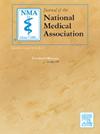Addressing visual learning equity in undergraduate dermatology education: Skin color representation across dermatology lecture images at Rutgers New Jersey Medical School
IF 2.5
4区 医学
Q1 MEDICINE, GENERAL & INTERNAL
引用次数: 0
Abstract
Minimally-melanated skin has been the standard for dermatologic education. Research has shown that the lack of brown and black images in dermatologic medical education may contribute to unequal early recognition of diseases across different skin types. Promoting visual equity in educational resources throughout undergraduate medical education may allow for students to improve their confidence in identifying skin lesions in patients of color. Dermatology lectures at Rutgers New Jersey Medical School (NJMS) were examined using the New Immigrant Survey (NIS) Skin Color Scale. Four pre-clerkship lectures featuring various skin lesions were analyzed and images were categorized as light/white, medium/brown, and dark/black skin types. The light/white skin category was the most heavily represented accounting for 59.5 % (n = 185) of all images across the four lectures, medium/brown skin type accounted for 16.1 % (n = 50), and dark/black skin type was 24.4 % (n = 76). Across the four lectures, there were 109 dermatologic conditions covered. Of the 109, 35 (32 %) only included images from one skin tone, which was usually light/white skin, whereas 17 (16 %) included images of all three skin types. INSTITUTION is located in Newark, New Jersey a diverse community with 48.2 % of its residents identifying as Black/African American and 36.8 % identifying as Hispanic/Latino in 2022. Currently, there have been efforts at INSTITUTION to promote visual learning equity, especially to represent the community it resides in. Addressing this disparity in medical education is a vital step toward achieving more equitable healthcare practices and outcomes for patients.
解决本科皮肤病学教育中的视觉学习公平性:罗格斯新泽西医学院皮肤病学讲座图像中的肤色表现。
轻度黑化皮肤一直是皮肤科教育的标准。研究表明,皮肤医学教育中缺乏棕色和黑色图像可能会导致对不同皮肤类型疾病的早期识别不平等。在整个本科医学教育中促进教育资源的视觉公平可以使学生提高他们识别有色人种患者皮肤病变的信心。罗格斯新泽西医学院(NJMS)的皮肤病学讲座使用新移民调查(NIS)肤色量表进行了检查。我们分析了四次关于各种皮肤病变的实习讲座,并将图像分类为浅/白、中/棕色和深/黑皮肤类型。光/白色皮肤类别代表最严重的占59.5 % (n = 185)所有图片的四个讲座、中/棕色皮肤类型占16.1 % (n = 50),和黑/黑皮肤类型是24.4 % (n = 76)。在这四堂课中,涉及了109种皮肤病。在109个样本中,35个(32 %)只包含了一种肤色的图像,通常是浅色/白色的皮肤,而17个(16 %)包含了所有三种皮肤类型的图像。机构位于新泽西州纽瓦克,这是一个多元化的社区,到2022年,48.2% %的居民认为是黑人/非裔美国人,36.8% %的居民认为是西班牙裔/拉丁裔。目前,INSTITUTION一直在努力促进视觉学习公平,特别是代表它所在的社区。解决医学教育中的这种差异是朝着为患者实现更公平的医疗保健实践和结果迈出的重要一步。
本文章由计算机程序翻译,如有差异,请以英文原文为准。
求助全文
约1分钟内获得全文
求助全文
来源期刊
CiteScore
4.80
自引率
3.00%
发文量
139
审稿时长
98 days
期刊介绍:
Journal of the National Medical Association, the official journal of the National Medical Association, is a peer-reviewed publication whose purpose is to address medical care disparities of persons of African descent.
The Journal of the National Medical Association is focused on specialized clinical research activities related to the health problems of African Americans and other minority groups. Special emphasis is placed on the application of medical science to improve the healthcare of underserved populations both in the United States and abroad. The Journal has the following objectives: (1) to expand the base of original peer-reviewed literature and the quality of that research on the topic of minority health; (2) to provide greater dissemination of this research; (3) to offer appropriate and timely recognition of the significant contributions of physicians who serve these populations; and (4) to promote engagement by member and non-member physicians in the overall goals and objectives of the National Medical Association.

 求助内容:
求助内容: 应助结果提醒方式:
应助结果提醒方式:


